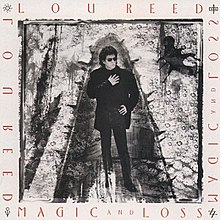Magic and Loss
| Magic and Loss | ||||
|---|---|---|---|---|
 |
||||
| Studio album by Lou Reed | ||||
| Released | January 14, 1992 | |||
| Recorded | April 1–27, 1991 | |||
| Studio | The Magic Shop, New York City | |||
| Genre | Rock | |||
| Length | 58:27 | |||
| Label | Sire | |||
| Producer | Lou Reed, Mike Rathke | |||
| Lou Reed chronology | ||||
|
||||
| Professional ratings | |
|---|---|
| Review scores | |
| Source | Rating |
| AllMusic | |
| Chicago Tribune | |
| Encyclopedia of Popular Music | |
| Entertainment Weekly | B− |
| NME | 10/10 |
| Orlando Sentinel | |
| Q | |
| Rolling Stone | |
| The Rolling Stone Album Guide | |
Magic and Loss is the 16th album by Lou Reed. Originally released in 1992 on Sire Records, the concept album was Reed's highest peaking album on the UK Albums Chart, reaching No. 6.
Magic and Loss was originally intended to be primarily about themes of magic after hearing stories about magicians in Mexico. However, when tragedy struck during the writing process, Reed expanded the album's focus to themes of loss and death as well. Inspired in part by the illnesses and eventual deaths of two close friends, Magic and Loss was written for songwriter Doc Pomus, who had given Reed his start in the music business some 25 years earlier, and a woman Reed has identified as "Rita", popularly assumed to be Rotten Rita, who along with Reed was a familiar figure at Andy Warhol's studio, the Factory, in the mid-to-late '60s. Photographs of Pomus and a woman's face can be seen at the center of the lyric booklet included with the CD release.
Jazz singer Little Jimmy Scott performs the backing vocal on track 3, "Power and Glory". Reed's live performance of the album filmed on March 18, 1992 at Pinewood Studios in London was released on VHS and LD.
The single "What's Good"/"The Thesis", released in March, was Reed's second #1 hit (after "Dirty Blvd.") on the Billboard Modern Rock Tracks chart, occupying the top spot for three weeks. The 12" version of the release contained Reed's reading of "Harry's Circumcision" and "A Dream". A longer version of "What's Good" was previously released on the 1991 soundtrack album to Until the End of the World.
...
Wikipedia
